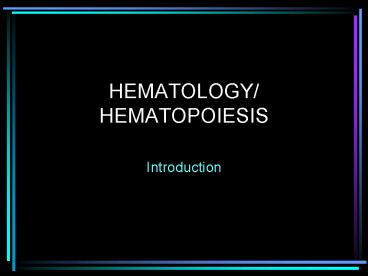HEMATOLOGY/ HEMATOPOIESIS PowerPoint PPT Presentation
1 / 33
Title: HEMATOLOGY/ HEMATOPOIESIS
1
HEMATOLOGY/HEMATOPOIESIS
- Introduction
2
HEMATOLOGYIntroduction
- Study of blood its components
- Window of rest of body
3
BLOODRaison detre
- Delivery of nutrients
- Oxygen
- Food
- Vitamins
- Removal of wastes
- Carbon dioxide
- Nitrogenous wastes
- Cellular toxins
- Repair of its conduit
- Protection versus invading microorganisms
- Multiple cellular acellular elements
4
HEMATOLOGYDivisions
- Red Blood Cells/Oxygen CO2 transport
- White Blood Cells/Protection versus
microorganisms - Coagulation/platelets/Maintenance of vascular
integrity
5
HEMATOLOGYHematopoiesis
- In humans, occurs in bone marrow exclusively
- All cellular elements derived from pluripotent
stem cell (PPSC) - PPSC retains ability to both replicate itself and
differentiate - Types of differentiation determined by the
influence of various cytokines
6
HEMATOPOIESIS
Committed Stem Cells
7
RED BLOOD CELLSIntroduction
- Normal - Anucleate, highly flexible biconcave
discs, 80-100 femtoliters in volume - Flexibility essential for passage through
capillaries - Major roles - Carriers of oxygen to carbon
dioxide away from cells
8
(No Transcript)
9
ERYTHROPOIETIN
- Cytokine - Produced in the kidney
- Necessary for erythroid proliferation and
differentiation - Absence results in apoptosis (programmed cell
death) of erythroid committed cells - Anemia of renal failure 2 to lack of EPO
10
ERYTHROPOIETINMechanism of Action
11
ERYTHROPOIETINMechanism of Action
- Binds specifically to Erythropoietin Receptor
- Transmembrane protein cytokine receptor
superfamily - Binding leads to dimerization of receptor
- Dimerization activates tyrosine kinase activity
12
ERYTHROPOIETINMechanism of Action
- Multiple cytoplasmic nuclear proteins
phosphorylated - Nuclear signal sent to activate production of
proteins leading to proliferation and
differentiation
13
ERYTHROPOIETINRegulation of Production
14
(No Transcript)
15
ErythropoietinResponse to Administration
rhuEPO 150 u/kg 3x/wk
16
RBC Precursors
- Pronormoblast
- Basophilic normoblast
- Polychromatophilic Normoblast
- Orthrochromatophilic Normoblast
- Reticulocyte
- Mature Red Blood Cell
- 5-7 days from Pronormoblast to Reticulocyte
17
(No Transcript)
18
(No Transcript)
19
(No Transcript)
20
(No Transcript)
21
(No Transcript)
22
RBC Assessment
- Number - Generally done by automated counters,
using impedance measures - Size - Large, normal size, or small all same
size versus variable sizes (anisocytosis). Mean
volume by automated counter - Shape - Normal biconcave disc, versus
spherocytes, versus oddly shaped cells
(poikilocytosis) - Color - Generally an artifact of size of cell
23
(No Transcript)
24
Red Blood CellsNormal Values
25
RETICULOCYTE
- Young red blood cell still have small amounts of
RNA present in them - Tend to stain somewhat bluer than mature RBCs on
Wright stain (polychromatophilic) - Slightly larger than mature RBC
- Undergo removal of RNA on passing through spleen,
in 1st day of life - Can be detected using supravital stain
- Important marker of RBC production
26
(No Transcript)
27
RETICULOCYTE COUNTAbsolute Value
- Retic x RBC Count
- eg 0.01 x 5,000,000 50,000
- Normal up to 100,000
- More accurate way to assess bodys response to
anemia
28
ANEMIACauses
- Blood loss
- Decreased production of red blood cells (Marrow
failure) - Increased destruction of red blood cells
- Hemolysis
- Distinguished by reticulocyte count
- Decreased in states of decreased production
- Increased in destruction of red blood cells
29
(No Transcript)
30
RBC DESTRUCTION - EXTRAVASCULARMarkers
- Heme metabolized to bilirubin in macrophage
globin metabolized intracellularly - Unconjugated bilirubin excreted into plasma
carried to liver - Bilirubin conjugated in liver excreted into bile
then into upper GI tract - Conjugated bilirubin passes to lower GI tract
metabolized to urobilinogen, which is excreted
into stool urine
31
RBC DESTRUCTION - INTRAVASCULAR
- Free Hemoglobin in circulation leads to
- Binding of hemoglobin to haptoglobin, yielding
low plasma haptoglobin - Hemoglobin filtered by kidney reabsorbed by
tubules, leading to hemosiderinuria - Capacity of tubules to reabsorb protein exceeded,
yielding hemoglobinuria
32
INTRAVASCULAR HEMOLYSIS
33
HEMOLYTIC ANEMIACommonly used Tests
Problems with sensitivity specificity

